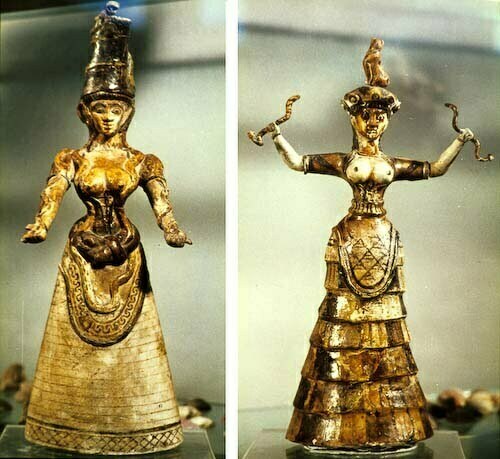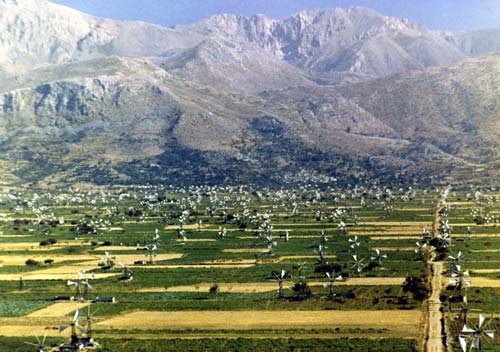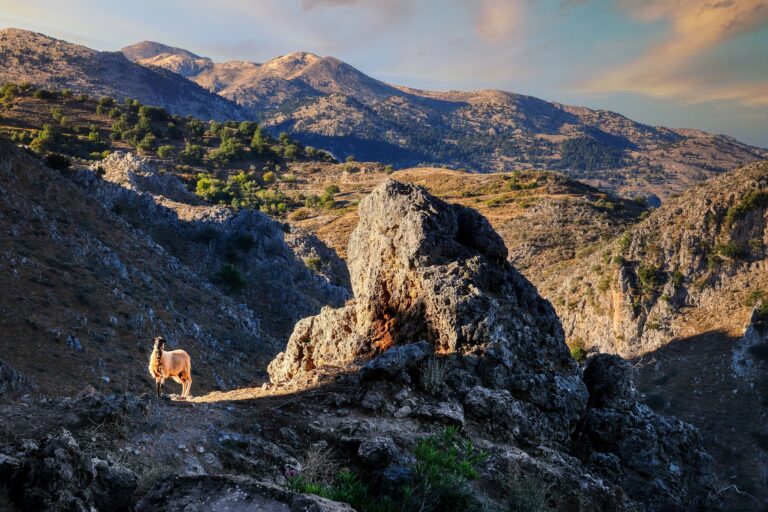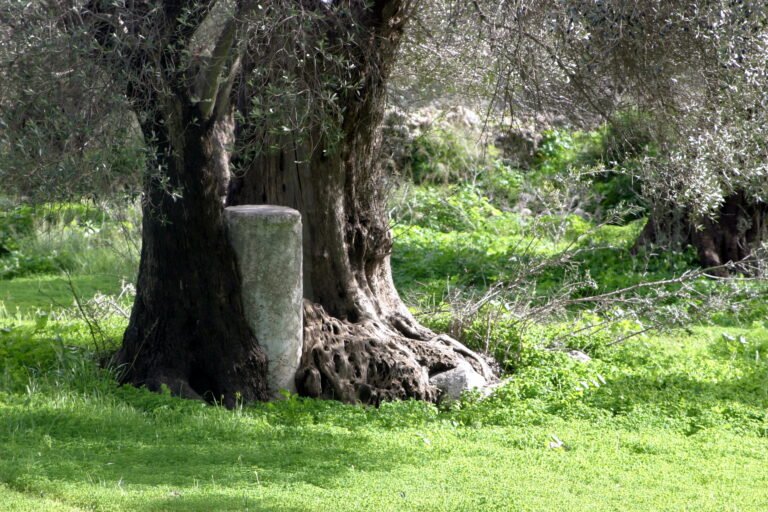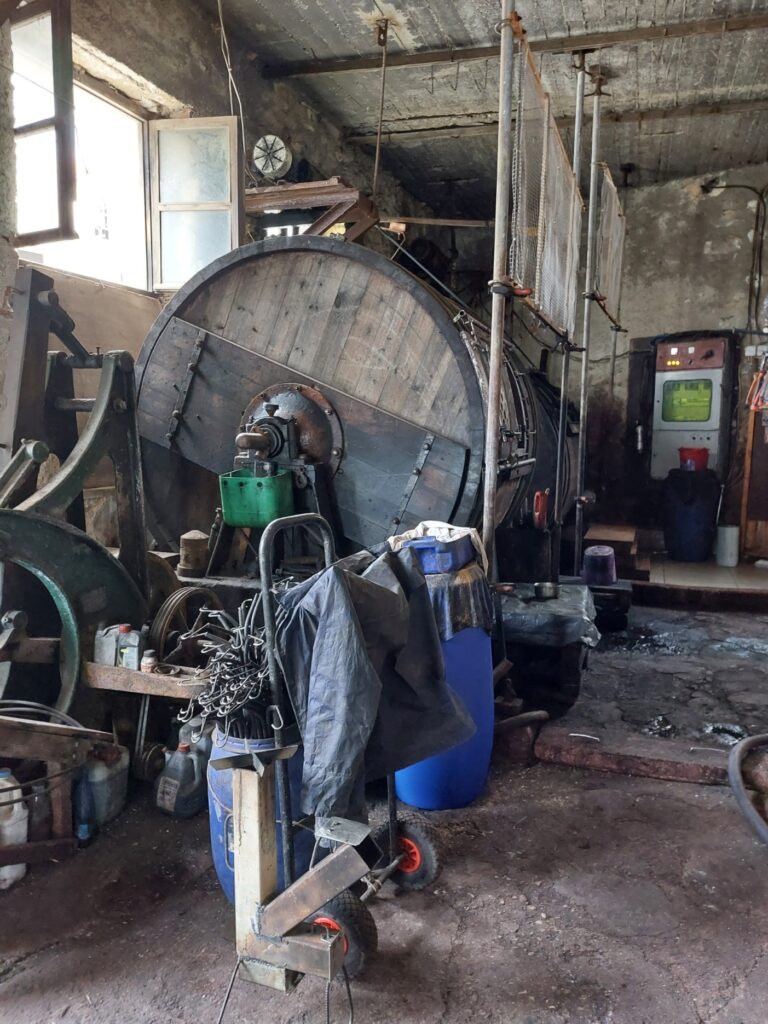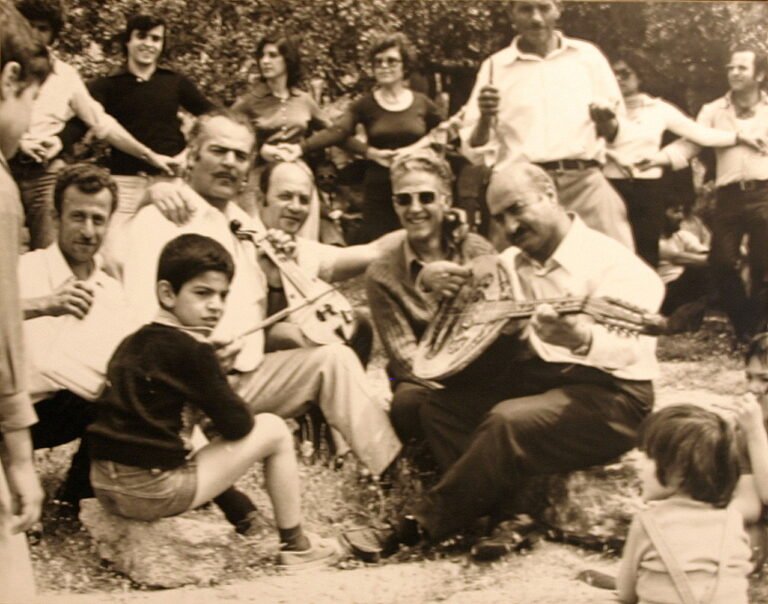Evans, Knossos and the Minoans – Facts and Forgeries
When you look at the advertisements for Crete, usually provided by the Greek tourist board, a huge amount of publicity is given to the ‘great Minoan civilisation’ discovered by Arthur Evans at the turn of the 20th century. Coach tours are offered to Knossos, the Disneyland of archaeology, where Evans poured concrete to recreate his ideas of what this fine civilisation meant.
He has written about a ‘pax Minoica’, a society that lived in peace under a matriarchal dynasty based on the legend of King Minos. A society of art and bull jumping and palaces with plumbing. It all sounds rather dreamlike. Perhaps it was.
After all, Evans invented the Minoans. The name came from the legend of King Minos who demanded Athenians to offer annual tribute to Crete of young men and maidens to be fed to the ‘minotaur’, the legendary half-man half-bull imprisoned in the labyrinth. Theseus came to Crete to slay the minotaur, and was helped by Ariadne, the daughter of Minos, with whom he fell in love after the death of the minotaur etc etc. Further legends include Daedelus and his son Icarus who flew too near the sun, the wax in the feathers melted and he was plunged to Earth. The legends go on, but none of them tell us anything about who lived in Crete in the first three millennia BC.
Frescos
One of the most stunning of Evans’s discoveries, was the frescoes he found at Knossos. Today we can see them in all their glory in the Archaeological Museum in Iraklion Crete. However, if you look closely you will see an indication of what Evans actually found, very little in fact, just tiny portions of remaining painted plaster. So where did these frescoes, these pictures of actual Minoan life come from?
Here is a reproduction of a book review by Mary Beard. The book she is reviewing is called ‘Knossos and the Prophets of Modernism’ by Cathy Gere.
“The masterpieces of Minoan art are not what they seem. The vivid frescoes that once decorated the walls of the prehistoric palace at Knossos in Crete are now the main attraction of the Archaeological Museum in the modern city of Heraklion, a few miles from the site of Knossos. Dating from the early or mid-second millennium BC, they are some of the most famous icons of ancient European culture, reproduced on countless postcards and posters, T-shirts and refrigerator magnets: the magnificent young “prince” with his floral crown, walking through a field of lilies; the five blue dolphins patrolling their underwater world between minnows and sea urchins; the three “ladies in blue” (a favourite Minoan colour) with their curling black hair, low-cut dresses, and gesticulating hands, as if they have been caught in mid-conversation. The prehistoric world they evoke seems in some ways distant and strange—yet, at the same time, reassuringly recognisable and almost modern.

The truth is that these famous icons are largely modern. As any sharp-eyed visitor to the Heraklion museum can spot, what survives of the original paintings amounts in most cases to no more than a few square inches. The rest is more or less imaginative reconstruction, commissioned in the first half of the twentieth century by Sir Arthur Evans, the British excavator of the palace of Knossos (and the man who coined the term “Minoan” for this prehistoric Cretan civilization, after the mythical King Minos who is said to have held the throne there). As a general rule of thumb, the more famous the image now is, the less of it is actually ancient.
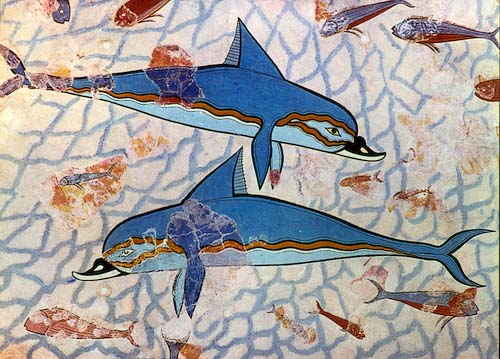
Most of the dolphin fresco was painted by the Dutch artist, architect, and restorer Piet de Jong, who was employed by Evans in the 1920s (and whose watercolours and drawings of archaeological finds in Athens, Knossos, and elsewhere were featured in a 2006 exhibition at the Benaki Museum in Athens, curated by John Papadopoulos). The “Prince of the Lilies” is an earlier restoration, from 1905, by the Swiss artist Émile Gilliéron. In this case it is far from certain that the original fragments—a small piece of the head and crown (but not the face), part of the torso, and a piece of thigh—ever belonged to the same painting.
The records of the original excavation suggest that they were found in the same general area of the ancient palace, but not particularly close together. And despite Gilliéron’s best efforts, the resulting “prince” (there is, of course, no evidence beyond the so-called “crown” for his royal status) is anatomically very awkward; his torso and head apparently face in different directions. The history of the “ladies in blue” is even more complicated. This painting was first recreated by Gilliéron after the discovery of a few fragments in the early years of the twentieth century, but that restoration was itself badly damaged in an earthquake in 1926 and re-restored by Gilliéron’s son (also Émile). So in this case, several of the small parts of the painting that now appear to be authentic are in fact mock-ups of the original surviving fragments that were themselves lost in the earthquake.
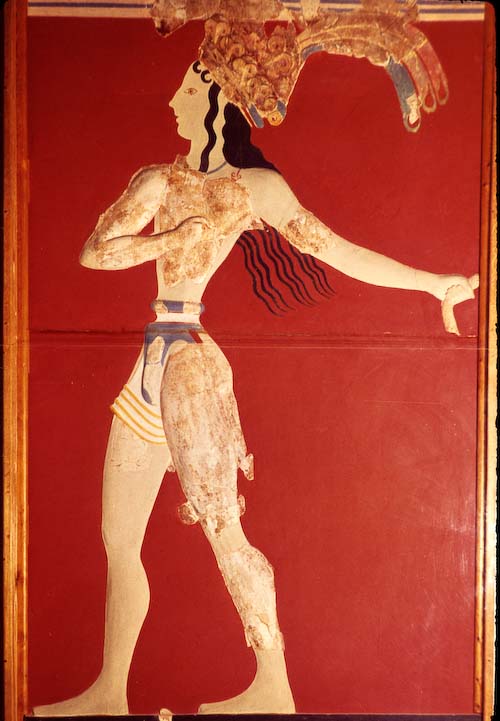
It is perhaps no wonder that when Evelyn Waugh visited Heraklion in the 1920s he found a disconcertingly modern collection of paintings in the museum. “It is impossible to disregard the suspicion,” he wrote in Labels (an account of his Mediterranean travels, published in 1930), “that their painters have tempered their zeal for accurate reconstruction with a somewhat inappropriate predilection for covers of Vogue.”
The story of the ancient palace of Knossos itself is much the same. Instantly recognisable with its squat red columns, ceremonial staircases, and “throne rooms,” it is the second most visited of all archaeological sites in Greece, attracting almost a million visitors each year. Yet none of those columns are ancient; they are all restorations (or, in his words, “reconstitutions”) by Evans. As Cathy Gere crisply puts it in her brilliant study of the role of Knossos in twentieth-century culture, Knossos and the Prophets of Modernism, the palace “enjoys the dubious distinction of being one of the first reinforced concrete buildings ever erected on the island.” Evans’s own house nearby, the Villa Ariadne, named for the mythical daughter of Minos and the bride of Dionysus, is another.

There is still debate about just how misleading Evans’s reconstitution of the prehistoric palace is. Certainly, there is little justification for any of the elaborate upper stories that are now visible on the site, or even for the exact location of the frescoes that he reproduced on the rebuilt walls. In some cases what we now see must be wrong. A copy of the dolphin fresco, for example, is displayed on one of the walls of the “Queen’s Megaron” (or Hall). In fact the places where the fragments were found make it much more likely that it was a floor decoration on an upper story, which fell through into the “Queen’s Megaron” when the building collapsed.
It is also clear enough, as the title “Queen’s Megaron” itself hints, that Evans’s preconceptions about Minoan society—a peace-loving monarchy, with a powerful role for women and a mother goddess at the centre of the religious system—strongly influenced his reconstructions, not only of the architecture and decoration but of the other finds too. A classic case of this is two famous faience figurines of “snake goddesses” (a key figure in Evans’s Minoan pantheon) unearthed on the site. “Snake goddesses,” or “snake priestesses,” they may have been, but once again considerably fewer of the original objects survives than what you now see in the museum display. Everything below the waist of one is a restoration; most of the snakes as well as the head and face of the other are the work of Halvor Bagge, one of the other artists in Evans’s team.
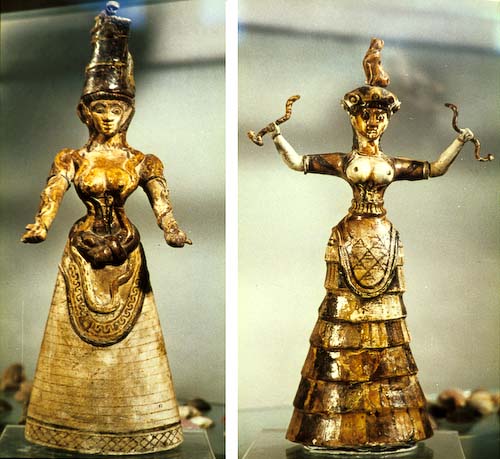
In some recent accounts of the history of Minoan archaeology, Evans himself has taken a lot of criticism. At best, he has seemed a dupe of his own obsessions with a particular vision of prehistory and of his fixation with the idea of a primitive mother goddess (a fixation unconvincingly explained in J.A. MacGillivray’s hostile 2000 biography, Minotaur, by the loss of Evans’s own mother when he was only six years old). At worst, he has been presented as a rich, upper-class racist, working out his sexual hang-ups and his British imperialist prejudices on the archaeology of Minoan Crete.
Evans is vulnerable to some of these charges. On any estimate, he was an archaeologist of “the old school.” He was only able to excavate Knossos because he bought the site wholesale, and he lived almost a parody of an English expatriate life there. According to the account in Dilys Powell’s memoir The Villa Ariadne (1973), Evans refused ever to drink Cretan wine and had French wine, gin, and whisky, as well as English jam and tinned meat, specially imported to Crete at huge cost. (Though she is better known as a movie critic, Powell had been married to the British archaeologist Humfry Payne and knew the set-up at Knossos well.) Evans was also capable of writing with contempt of the “inferior races,” and at the age of seventy-four he was convicted in London of “an act in violation of public decency” with a young man (he had been married briefly—but whether this offence was part of a habitual pattern of conduct or a one-off incident we do not know).
There is also the question of quite how far he was aware of the brisk trade in Minoan forgeries during the early decades of the twentieth century, many of which he authenticated, some of which he bought for himself. Apart perhaps from prehistoric “Cycladic figurines,” no category of objects has ever been more systematically faked than Minoan antiquities. In a brilliant real-life detective story, Mysteries of the Snake Goddess, Kenneth Lapatin has tried to track down the provenance of all the known snake goddess figurines, apart from those definitely excavated at Knossos or other major sites. These have often been the prized objects of major museums (one is owned by the Museum of Fine Arts in Boston, another by the Fitzwilliam Museum in Cambridge; another—bought by Evans himself is in the Ashmolean at Oxford).
Lapatin shows that almost all of these, as well as a substantial number of other “Minoan” objects, are certain forgeries. But more than that, he makes a strong case for the involvement in this business of the Swiss restorers Émile Gilliéron, père and fils (“restoring” by day, as it were, and “faking” by night). Evans may well have been entirely ignorant of the clandestine activities of his trusted staff. But his desperation to identify more artifacts that would confirm his own vision of Minoan culture certainly encouraged their activities and he was, no doubt, easy to persuade to add his authority to their productions (after all, the bona fide “restorations” and the “fakes” really must have looked identical—they were made by the same people).
Yet some of the accusations now commonly levelled against Evans look very glib. It is easy to claim that archaeology is a branch of imperialism, but much harder to make that accusation stick in any particular instance. It is often said, for example, that Evans was interpreting Minoan civilization and the basis of its power in the early second millennium BC according to the model of the British Empire: the Minoan control of the sea (“thalassocracy”) was a reflection of the power of the British navy. As one archaeologist has recently—and crassly—put it, Evans’s Minoans were “travelling and trading all over the Mediterranean, thanks to their British (sorry, Minoan) ‘thalassocracy.’”
Maybe. But it was no British imperialist who first identified the importance of Cretan sea power; it was the Greek historian Thucydides, writing in the fifth century BC, who claimed in his History that “Minos was the first person to organise a navy…he ruled over the islands of the Cyclades in most of which he founded colonies.” In all likelihood, this well-known passage was the direct inspiration of the classically educated Evans, not any desire to find his own imperial experience prefigured in prehistoric Crete.
One enormous virtue of Cathy Gere’s Knossos and the Prophets of Modernism is that she leaves to one side the barren debate over whether Evans himself was a good or a bad character, either archaeologically or politically. Her subject is not so much the excavation of Knossos but the role that Minoan archaeology played within twentieth-century culture (and, conversely, how twentieth-century culture, from Evans on, projected its own concerns onto Minoan archaeology). It was at Knossos, she argues, that prehistory gave shape to a prophetic modernist vision, which repeatedly reinvented the Minoans as Dionysiac, peaceable protofeminist’s in touch with their inner souls.
Admittedly, they were presented in subtly different shades as time and politics moved on (more or less free love, for example), but they almost always appeared in stark contrast to the militaristic Aryan culture of their roughly contemporary prehistoric rivals, the Mycenaeans. From de Chirico to the Summer of Love, from Jane Ellen Harrison to Freud and H.D., theorists, artists, and dreamers found their future in the remote Minoan past.
Gere writes with clarity and wit, but she never sacrifices the fascinating complexity of her tale to a simple storyline. She is excellent, for example, on the “blurry boundary between restorations, reconstructions, replicas, and fakes,” insisting that there is no clear and undisputed line that separates the processes of archaeology from those of invention or forgery. One of her most telling examples is the so-called “Ring of Nestor.” According to Evans’s own account (which is suspiciously vague on some of the details), this gold signet ring had been dug up by peasants on the Greek mainland near the site of Pylos, the legendary home of King Nestor, one of Homer’s heroes—hence the ring’s nickname. On the death of the finder, it passed to a neighbour, at which point Evans got to hear about it and “thanks to the kindness of a friend” (as he put it) he was shown an impression of its design. He immediately went to Pylos to acquire it. For, although it was not strictly Cretan, he believed that the intricate image on its bezel represented the Minoan Mother Goddess among scenes from the afterlife; and he was particularly excited by the vague traces of what he interpreted as butterflies and chrysalises (of the common white), “symbols of the life beyond.”
There are strong reasons to suspect that this ring was a forgery by the younger Gilliéron, who is actually supposed to have confessed to its fabrication. If that is the case, then there was—as Gere nicely observes—a bizarre sequel. For Evans employed Gilliéron to make a whole series of images of his new “find” in support of his own interpretation of the iconography, beginning with a photo enlargement, moving to a drawing of the figures enlarged twenty times, and finally transforming the scene into a full-colour fresco, in which all the little scratches and blobs in the original engraving were turned into faithful depictions of Evans’s interpretations.
This is where the boundary between restoration and forgery is at its most blurry. The idea of Gilliéron, as artist and restorer, dutifully producing beautiful, and increasingly magnified, images of his own handiwork as a forger is close to absurd. Like Gere, we cannot help wondering whether he would have been “delighted or disconcerted” when Evans gave him that particular job.
Gere is also good at tracking the two-way influences between the restorations of the material at Knossos and contemporary art movements. Waugh was quite right to spot the similarity between what he saw in the Heraklion museum and the covers of Vogue, but the relationship between the two was surely more complicated than he thought. Art historians have been happy to concede that the influence on Art Nouveau of the frescoes from Knossos (albeit as restored by Gilliéron) was almost as strong as the influence of Art Deco on Gilliéron’s restorations. Early-twentieth-century painters and sculptors were closely observing the newly discovered primitive masterpieces of Crete and incorporating them in their work.
On the dust jacket of Knossos and the Prophets of Modernism is a splendid photograph of Evans’s huge concrete replica of what he called “the Horns of Consecration,” one of the most characteristic Minoan religious symbols, supposedly derived from the horns of the “sacred bull.” This replica now stands prominently just next to the ancient palace at Knossos, and (as Gere points out) looks more like the work of Barbara Hepworth than anything else. Modernist sculpture may, in this case, have inspired the work of Evans’s restorers. But Hepworth herself visited Knossos in the 1950s. How “the Horns of Consecration” appeared to her then, and what artistic inspiration she may have drawn from it, we can only guess.
A particularly intriguing artistic link with Knossos is found in the work of the painter Giorgio de Chirico. An Italian by origin, but born in Greece in 1888 and schooled there, de Chirico produced a series of Cretan paintings, focusing on the figure of Ariadne set within a bleak and troubling modernist landscape. His Ariadne is based on a famous Greco-Roman statue from the Vatican Museum, showing the Cretan princess sleeping after she has been abandoned by Theseus (whom she had helped to kill the Cretan Minotaur), though before the god Dionysus has arrived to “rescue” her. But as Gere notes, the setting in which she lies, with its industrial columns and open piazzas, is strikingly reminiscent of the concrete reconstruction of the palace at Knossos (see illustration on page 58). It turns out (and seems almost too good to be true) that as a child, de Chirico had been taught drawing by Emile Gilliéron, and when the de Chirico family moved to Munich in 1905, Giorgio attended the very art school where Gilliéron himself had been trained.
Yet even with these biographical details and with such clearly documented links between the characters, the pattern of influence remains hard to pin down. Whatever the young de Chirico learned from his childhood teacher, those drawing lessons took place before Gilliéron had undertaken any major work at Knossos. And indeed the apparent reminiscences of the modernist architecture of Knossos in de Chirico’s paintings predated the large-scale architectural reconstruction of the palace site by more than a decade. Perhaps we should be thinking of the influence flowing from de Chirico to the restorers of the palace. More likely, as Gere implies, the reinvention of primitive Knossos was a much more communal cultural project than that. We should not see it simply as the construction of Evans and his staff, but as a shared obsession of the early-twentieth-century intellectual elite. This obsession drew not only on a powerful combination of archaeology and modernism, but also on new views of the nature of ancient Greek culture (largely inspired by Nietzsche—who was certainly de Chirico’s bedside reading) and on a radical sense that the distant past could provide a way of rethinking the present.
Not that Gere entirely neglects the investment of Evans himself in the whole Minoan project. Apart from the occasional flight of fancy (we find more speculation here on how the loss of Evans’s mother caused his fixation with the Cretan Mother Goddess), she is much more levelheaded, and evenhanded, than many recent writers—particularly on questions of race. There is no doubt that Evans shared the casual disdain for other cultures and ethnicities that was typical of his age and class. Gere admits that it is not hard to assemble from his writing a dossier of quotations about “niggers” and “negroid influence” that would make a strong case against him “as an unreconstructed Con-radian villain.” Yet, she argues, that would be to miss the puzzling contradictions that must complicate any such simple picture. Virulently prejudiced he no doubt was; but at the same time he believed that the origins of the distinctive character of Minoan civilization lay partly in Egypt and Libya, partly in sub-Saharan Africa.
For Evans, the Minoans were emphatically not pure Greek, and he would have been irritated to learn that the “Linear B” tablets, which he excavated at Knossos (and which remained undeciphered in his lifetime), were actually written in an early form of the Greek language. In his view, as Gere summarises it, Crete rose above the inertia of her northern neighbours as a result of successive waves of immigration from the south, including that of “negroized elements” hailing from Libya and the Nile Valley.
And Evans lays particular stress on the trade and caravan routes leading from the African interior (for example, from Sudan and Darfur) to the coast— and so to within easy sailing reach of Crete. This is not so very far from the arguments of Martin Bernal’s Black Athena (1987).
It is ironic, given his modern reputation as an out-and-out racist, that one of the most tendentious restorations of a Minoan fresco, carried out under his direction and partly to his bidding, actually introduced a pair of black African soldiers as major figures. Known by Evans as the “Captain of the Blacks” fresco, it was restored to show a Minoan warrior running ahead of two black comrades or subordinates. In fact the only evidence for the black soldiers is a handful of fragments of black paint, which need not have been from human figures at all.
But Evans was keen to find visual confirmation of his view that the Minoans used black “regiments” in their conquest of mainland Greece (these peace-loving people at home did not always hold back from military expansion overseas). He did not envisage an equal collaboration between black and white, of course. Even here, ideas of white racial superiority still hover awkwardly at the margins: not only in the very British military title given to the fresco but also in part of Evans’s imaginative description of the restored scene. “There is no reason to suppose,” he wrote condescendingly, “that negro mercenaries drilled by Minoan officers…were otherwise than well-disciplined.”
Knossos and the Prophets of Modernism traces the story of the modern engagement with Knossos from Evans’s first visit to Crete in the late nineteenth century almost up to the present day. It leads from the avant-garde art of de Chirico, through the famous archaeological obsessions of Freud and H.D. (“a psycho-archaeological folie à deux” that brought a version of Minoan primitivism to the analyst’s couch), to the frankly dotty ideas of matriarchal goddesses floated by Robert Graves and Marija Gimbutas.
The final act in this drama, however, has seen a strange reversal. Soon after the 1960s, when the Minoans had been conscripted into the popular imagination as a prehistoric version of hippie culture (lilies pointing to the ancient equivalent of flower power), the archaeological mood changed. Some controversial discoveries close to Knossos of children’s bones (carrying suspicious marks of butchery) raised the nasty possibility that the peace-loving Minoans had actually been human sacrificers. New research projects in the 1970s and 1980s focused on the networks of roads and fortifications with which the prehistoric elite of the palace of Knossos had strictly controlled their home territory—while scholarly attention also turned to the high- quality state-of-the-art weaponry that had generally been ignored in favor of Evans’s “lustral areas,” “bull dancers,” “saffron gatherers,” and lilies. So much for the pax Minoica.
But for Gere, this change of emphasis was essentially a return to the state of play before the excavation of Knossos began in 1900. As she points out, Evans’s first visits to Crete had been mainly concerned with the study of Bronze Age defenses and the road network. It was only after he had started excavating the palace that he coined the term “Minoan” and that early-twentieth-century archaeologists, artists, and thinkers combined their efforts to create an image of a peaceable, prepatriarchal prehistory to match.
The surprise is, however, that some discoveries of this latest period of archaeology have actually come to Evans’s support. As Gere reports, one of the most striking of these is a gold ring found in an excavation of a tomb at the site of Archanes, not far from Knossos. It carries a design that bears a clear resemblance to the “Ring of Nestor,” even featuring those otherwise unattested chrysalises. Is this proof then that, despite Evans’s suspicious story of the acquisition and despite the rumors of Gilliéron’s confession, the “Ring” was actually genuine?
Perhaps. And indeed some recent studies of the technique of its manufacture have tentatively pointed to a similar conclusion. But a rather more troubling explanation is also possible. Perhaps these early excavators and restorers of the site had so internalized the prehistoric culture they were partly uncovering and partly reinventing that their forgeries occasionally turned out to be accurate predictions of what would one day be discovered. That would be a yet more radical blurring of the boundary between authentic Minoan artifact and Minoan fake than even Gere has in mind.”
Table of Contents
Views: 534

